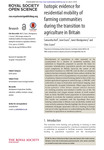Please use this identifier to cite or link to this item:
http://lib.hpu.edu.vn/handle/123456789/23564Full metadata record
| DC Field | Value | Language |
|---|---|---|
| dc.contributor.author | Neil, Samantha | en_US |
| dc.contributor.author | Evans, Jane | en_US |
| dc.contributor.author | Montgomery, Janet | en_US |
| dc.date.accessioned | 2016-10-11T05:37:18Z | |
| dc.date.available | 2016-10-11T05:37:18Z | |
| dc.date.issued | 2016 | en_US |
| dc.identifier.other | HPU4160673 | en_US |
| dc.identifier.uri | https://lib.hpu.edu.vn/handle/123456789/23564 | - |
| dc.description.abstract | Development of agriculture is often assumed to be accompanied by a decline in residential mobility, and sedentism is frequently proposed to provide the basis for economic intensification, population growth and increasing social complexity. In Britain, however, the nature of the agricultural transition (ca4000 BC) and its effect on residence patterns has been intensely debated. Some authors attribute the transition to the arrival of populations who practised a system of sedentary intensive mixed farming similar to that of the very earliest agricultural regimes in central Europe,ca5500 BC, with cultivation of crops in fixed plots and livestock keeping close to permanently occupied farmsteads. | en_US |
| dc.format.extent | 14 p. | en_US |
| dc.format.mimetype | application/pdf | - |
| dc.language.iso | en | en_US |
| dc.subject | Earth science | en_US |
| dc.subject | Environmental science | en_US |
| dc.subject | Ecology | en_US |
| dc.subject | Evolution | en_US |
| dc.subject | Development of agriculture | en_US |
| dc.subject | Neolithic | en_US |
| dc.subject | Sedentism | en_US |
| dc.subject | Mobility | en_US |
| dc.subject | Strontium | en_US |
| dc.subject | Isotope analysis | en_US |
| dc.title | Isotopic evidence for residential mobility of farming communities during the transition to agriculture in Britain | en_US |
| dc.type | Article | en_US |
| dc.size | 782KB | en_US |
| dc.department | Education | en_US |
| Appears in Collections: | Education | |
Files in This Item:
| File | Description | Size | Format | |
|---|---|---|---|---|
| 0556_Isotopicevidence.pdf Restricted Access | 782.66 kB | Adobe PDF |  View/Open Request a copy |
Items in DSpace are protected by copyright, with all rights reserved, unless otherwise indicated.
